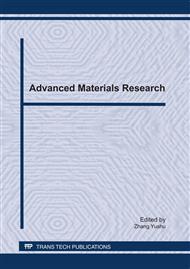p.460
p.465
p.470
p.475
p.479
p.483
p.487
p.492
p.497
The Mechanical Feature and Dependence of the pH-Sensitive Hydrogel
Abstract:
Tensile tests were conducted on poly (AAc-co-AAm) hydrogel sensitive to variations in environmental pH and ionic strength. Mechanical properties (Young’s modulus) were determined at different levels of swelling equilibrium. The results show that there are great shift in the modulus number between the swollen and unswollen states, corresponding to the maximum, the Young’s modulus data in the pH7 buffers is a decrease of 80%. The Poisson’s ratio of the samples tested in the pH2 with 1.0M ionic strength solution is nearly 0.5, which implying its incompressibility. Analyzing its inner structure, the reason may be the high polymer chains entangled highly, they can resist the deformation. The further investigations of SEM micrographs prove our suggestions about the microstructure change.
Info:
Periodical:
Pages:
479-482
Citation:
Online since:
February 2011
Authors:
Keywords:
Price:
Сopyright:
© 2011 Trans Tech Publications Ltd. All Rights Reserved
Share:
Citation:


